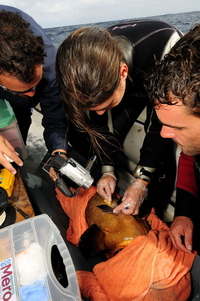|
|
WP3. BIODIVERSITY THREATS In broad terms, MPAs have to cope with at least five major threats: climate change; overfishing, attendant bycatch problems and ghost fishing; habitat damage; pollution (in-sea and land-based, diffuse and point source); ecosystem alterations caused by the introduction of alien species. A general consequence of these impacts is habitat fragmentation and reduced connectivity among populations, compromising species resilience. Defining boundaries to larval dispersal and gene flow in coastal marine species has major implication for integrated costal management, the conservation of marine biodiversity and ecosystem functioning, and for the planning of MPAs. The WP addresses the role and the impact of a number of biodiversity threats focusing on rocky shores and the connectivity of fish populations. This WP will make large use of genetic and biomolecular methods to define boundaries to larval dispersal and gene flow, indicating implications for coastal management and ecosystem functioning. Objectives.
Projects
WP 3.1 - Connectivity among populations of the genus Patella among Mediterranean Marine Protected Areas Supervisor: Dr. Massimo Ponti (CIRSA, Italy)
Methods. The genus Patella includes both rare species endangered and included in protection list (i.e. Patella ferruginea and Patella nigra) as well as species with large geographic distribution along the Mediterranean coasts (e.g. Patella caerulea and Patella rustica), but differing in larval dispersal capability. Genetic variability and structuring will be assessed by using nucleotidic markers with different levels of polymorphism (mitochondrial and nuclear DNA). Based on the level of intraspecific genetic structuring we will estimate gene flow between populations and, indirectly, the effective scales of larval dispersal. This approach should allow formulating hypotheses on environmental variables and ecological processes that could affect the distribution patterns and evaluate the impact of different human activities on genetic variability and dispersal capability of the species.
WP 3.2 - Connectivity of Mediterranean reef fish populations and MPA design Supervisor: Dr. Jose Antonio García Charton (UMU, Spain)
Methods. Estimation of post-larval, juvenile and adult abundances of selected fish species within and around a Mediterranean MPA (light traps, underwater visual censuses); study connectivity schemes (by genetic parentage methods) to directly track successful dispersal events; couple these results with oceanographic analyses to determine the extent to which these events are predictable; compare these results with a dispersion simulation model; extract conclusions for MPA design.
|
|
||
|
|
||||





_ridimensionare.jpg) Objectives.
The aim of this project is to analyse among Mediterranean MPAs the inter- and intra-specific levels of divergence and genetic structuring in species belonging the genus
Patella, and to compare the role of life history traits vs. hydrogeographic and anthropogenic barriers in causing effective discontinuity zone.
Objectives.
The aim of this project is to analyse among Mediterranean MPAs the inter- and intra-specific levels of divergence and genetic structuring in species belonging the genus
Patella, and to compare the role of life history traits vs. hydrogeographic and anthropogenic barriers in causing effective discontinuity zone.  Objectives. The objectives of the present project are: to understand causes and consequences of fish connectivity of a selected fish species; to link connectivity patterns to oceanographic dynamics; to establish MPA design criteria based on these results.
Objectives. The objectives of the present project are: to understand causes and consequences of fish connectivity of a selected fish species; to link connectivity patterns to oceanographic dynamics; to establish MPA design criteria based on these results.